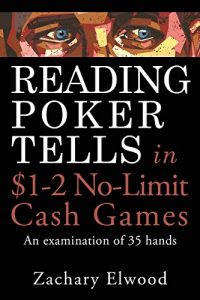$1-2 No-Limit Hold’em cash games are one of the most popular forms of poker played today. In this short ebook, Zachary Elwood examines 35 actual $1-2 NLHE hands, finding meaning in opponents’ physical and verbal behavior.
Zachary Elwood is the author of the books Reading Poker Tells (2012) and Verbal Poker Tells (2014). His first book, Reading Poker Tells, has been called the “best book on poker tells” by many players, professional and amateur alike.
In his latest ebook, Elwood explores what some common low-stakes behaviors are likely to mean and explains the “why” behind them. He then delves into ways of making practical, strategic use of that behavioral information.
Being “easy to read” can put recreational players at a big disadvantage. Perhaps most importantly, this book will help recreational poker players eliminate their own poker tells and compete on a more even-playing field with better players.
Behaviors discussed include:
• Staring at hole cards
• Double-checking hole cards
• Defensive eye contact
• Defensive chip handling
• Immediate calls
• Immediate bets versus delayed bets
• Agitated behavior from callers
• “Loose” relaxed behavior from bettors
• Premature reaching for chips
• Pauses and hesitations in betting motions
• Verbal clues
This book also contains an offer code for getting 20% off of Zachary Elwood’s other ebooks and his video series. His website is at www.readingpokertells.com.
Zachary Elwood is the author of the books Reading Poker Tells (2012) and Verbal Poker Tells (2014). His first book, Reading Poker Tells, has been called the “best book on poker tells” by many players, professional and amateur alike.
In his latest ebook, Elwood explores what some common low-stakes behaviors are likely to mean and explains the “why” behind them. He then delves into ways of making practical, strategic use of that behavioral information.
Being “easy to read” can put recreational players at a big disadvantage. Perhaps most importantly, this book will help recreational poker players eliminate their own poker tells and compete on a more even-playing field with better players.
Behaviors discussed include:
• Staring at hole cards
• Double-checking hole cards
• Defensive eye contact
• Defensive chip handling
• Immediate calls
• Immediate bets versus delayed bets
• Agitated behavior from callers
• “Loose” relaxed behavior from bettors
• Premature reaching for chips
• Pauses and hesitations in betting motions
• Verbal clues
This book also contains an offer code for getting 20% off of Zachary Elwood’s other ebooks and his video series. His website is at www.readingpokertells.com.






